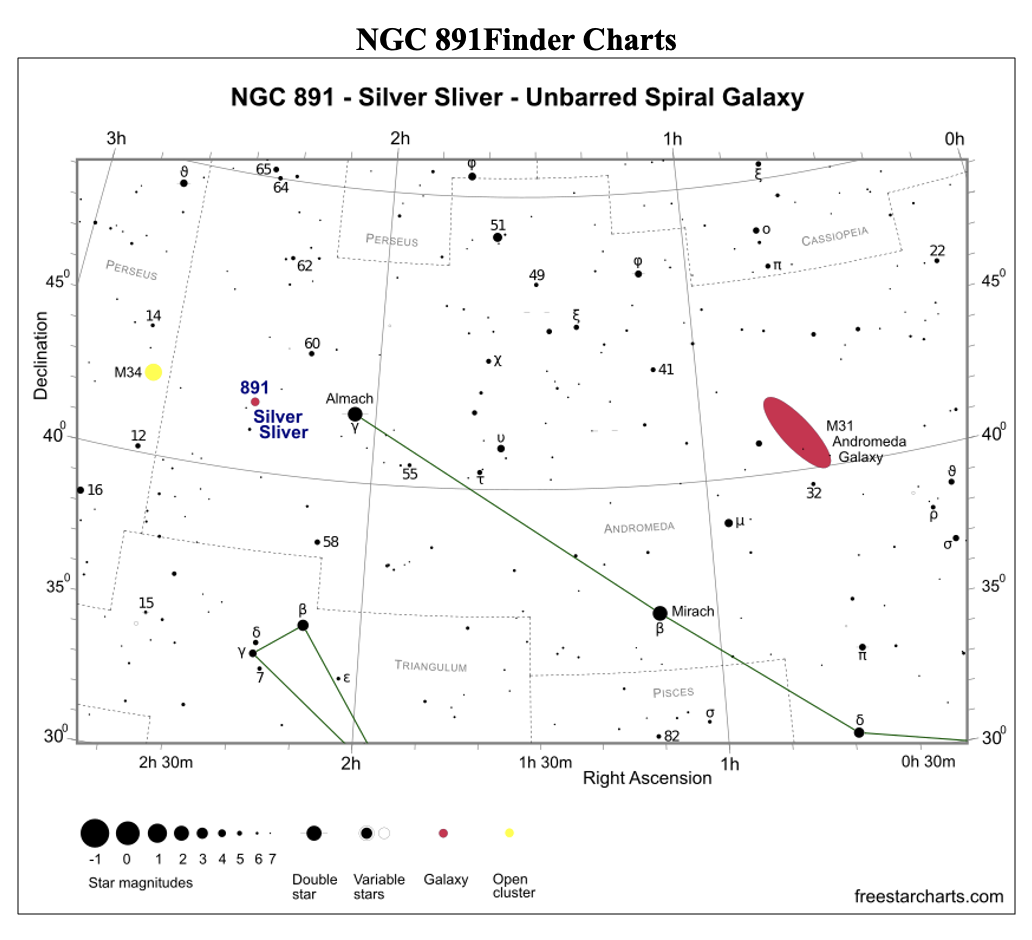by Glenn Chaple
NGC 891 – Spiral Galaxy Cluster in Andromeda (Magnitude 9.9, Size 12’ X 2’)
If you’re a fan of TV sci-fi shows and are old enough, the accompanying image of the edge-on spiral galaxy NGC 891 taken by astroimager Mario Motta should look oddly familiar. It appeared, along with images of other galaxies, during the closing credits of the mid-1960s sci-fi anthology “Outer Limits.”
 Typical of edge-on spirals, NGC 891 displays a luminous spindle shape bisected by a dark lane. This lane, created by dust clouds that inhabit the spiral arms, obscures the galaxy’s bright nucleus. As a result, NGC 891 is much darker than its listed magnitude of 9.9 might indicate. Although glimpsed with difficulty with apertures as small as 4 inches, this low surface brightness galaxy more realistically requires an aperture of 8 to 10 inches under a dark sky environment.
Typical of edge-on spirals, NGC 891 displays a luminous spindle shape bisected by a dark lane. This lane, created by dust clouds that inhabit the spiral arms, obscures the galaxy’s bright nucleus. As a result, NGC 891 is much darker than its listed magnitude of 9.9 might indicate. Although glimpsed with difficulty with apertures as small as 4 inches, this low surface brightness galaxy more realistically requires an aperture of 8 to 10 inches under a dark sky environment.
To find NGC 891, owners of GoTo telescopes need only enter its 2000.0 coordinates RA 2h22m33s and DEC +42o20’53” and press the button on the control paddle. I recommend, however, that you eschew the electronics and “go to” NGC 891 via the star-hop method. The reason? Your starting point is gamma (γ) Andromedae (Almach), 3 ½ degrees due west. Mirach is one of the finest double stars in the night sky, a dazzling amber and blue pair whose magnitude 2.3 and 5.0 components are 9.5 arc-seconds apart. What a great way to begin your journey to NGC 891!
 NGC 891 was discovered by (who else?) William Herschel on 6 October 1784 with an 18.7 inch reflecting telescope. He described it as “Considerably bright, much extended above 15' 3' broad, a black division 3 or 4' long in the middle.”
NGC 891 was discovered by (who else?) William Herschel on 6 October 1784 with an 18.7 inch reflecting telescope. He described it as “Considerably bright, much extended above 15' 3' broad, a black division 3 or 4' long in the middle.”
Most references assign a distance to NGC 891 of 30 million light years. Its apparent 12 arc-minute breadth translates to an actual size of 100,000 to 120,000 light years.
Here are your NGC 891 challenges: 1. Can you behold the beauty of the topaz and sapphire gem set Almach without being moved to tears? (OK, maybe hyperbole on my part, but this colorful pair is a stunning can’t miss sight.) 2. Can you glimpse NGC 891 with a telescope aperture less than 8 inches? 3. What is the smallest aperture that will capture the galaxy’s dust lane?
